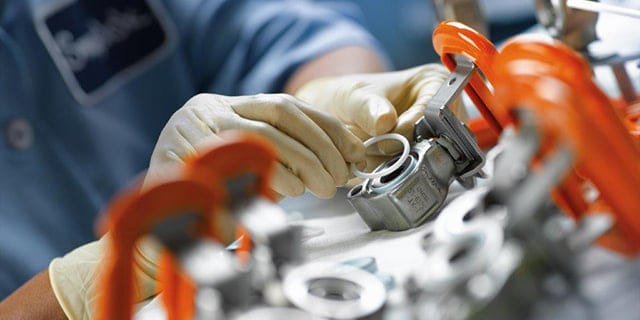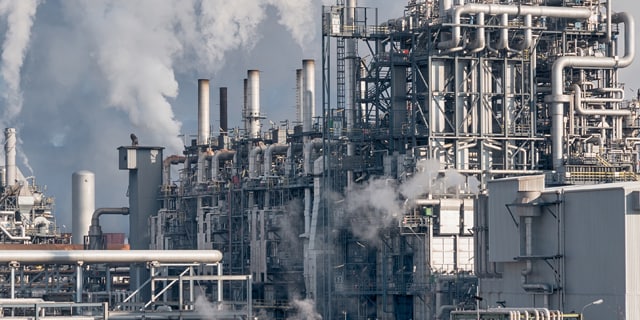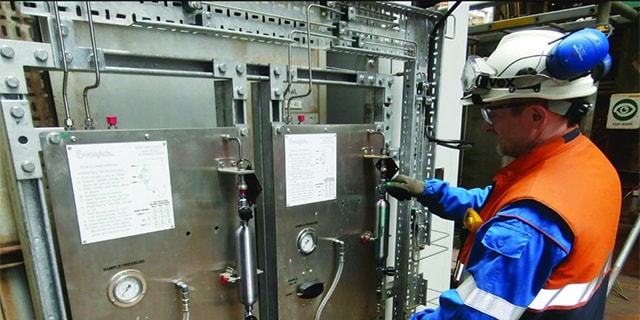What is a Block Valve & Configuration Options for Engineers

How to Isolate Industrial Fluid Systems with Block Valves
When performing industrial fluid system maintenance, safety is paramount. A single line’s pressure or flow inside represents a hazard to technicians changing a gauge or measurement device. This is why risk managers emphasize the necessity of isolating any fluid system line prior to maintenance.
It has become an industry and safety standard to design and install two block valves in sequence when bleeding out an energized leg in a fluid system. The double block valve sequence is one of the safest ways to achieve an essential state of zero pressure and zero flow.
There are two common approaches engineers typically take when designing two block valves to isolate fluid systems. First, engineers may add a third valve between the two block valves to vent or bleed off any pressure that may be leaking from the first block valve. Another viable option is to have the third valve divert the flow to a bypass loop around the section of the line that is under maintenance. Outlined below are both fluid system configurations, providing safety-focused design options for system isolation and maintenance.
Main Locations for Isolation Configurations in a Plant
For any fluid system line in a plant or industrial facility that may require maintenance, technicians must have some means of safely isolating that line. Some specific locations that require a configuration for isolation include:
- Any device or component that may require regular maintenance, such as a filter, valve, or transmitter.
- Any system, skid, or line that may need to be reconfigured, repaired, or replaced.
- Any section of the main process pipe that may need to be serviced or maintained.
- Any instrumentation line that comes off the process line (for example, a grab sample station, sampling system, or readings for pressure, temperature, or flow).
- Calibration fluids in sampling systems, as well as any sampling streams that may be switched on or off.
Options for Configuring Isolation
It is industry standard to avoid a situation in which there is only one block valve or no backup. If a single block valve has even a small leak across the seat, pressure can slowly build up in the line under maintenance, creating a safety hazard. Therefore, one of two main configurations for achieving isolation in a fluid line is encouraged:

1. Double-Block-and-Bleed (DBB)
A double-block-and-bleed configuration, or DBB, is the simplest configuration for isolating a fluid system. It is commonly used transitioning from the process line to an instrumentation line when using a process interface valve, or on a line that leads to an instrument or device, such as a transmitter. The three valves may be configured as a single manifold unit or as three separate components.
2. Bypass Loop
A bypass loop is a slightly more complicated configuration that not only isolates the fluid system line under maintenance, but also reroutes the flow so the process can continue to function during maintenance.
For example, the first block valve in bypass configuration may be a three-way valve — diverting flow around the section requiring maintenance. The system filter can now be changed out without requiring downtime. Another reason for a bypass is to avoid hydraulic shock or “water hammer” that results when there is a sudden system flow shutoff.

Isolate and Depressurize
The first step when preparing for maintenance on any fluid system is depressurization. When doing so, a best practice is to have two block valves in sequence to guard against pressure buildup in the section of the line under maintenance. A good valve should not leak across the seat, but this could happen. For example, if the line is outside, the sun may heat up the line and raise the pressure beyond the valve’s specified rating. Other potential scenarios include if the valve has not been properly maintained or if it’s the wrong valve choice for a positive shutoff. To guard against these and other possible leaks, a second block valve is necessary, along with a vent or bleed valve. Alternatively, in cases where downtime is not an option, a bypass loop that duplicates the components in the line under maintenance is an excellent choice.
Making the Right Block Valve Selection
The two most common choices for block valves in instrumentation lines are ball valves or needle valves. It is imperative that maintenance technicians check system specifications for the valve that is required for each system.
Ball Valves: Ball valves are good for quick shutoff and high flow. Additionally, the handles are helpful in indicating directional flow or shutoff. With liquid flow, however, a ball valve can create a hydraulic shock or “water hammer” because of the sudden shutoff that it causes, resulting in damage to pressure indicators, flow meters, and other components upstream of the shutoff. There are several ways to avoid hydraulic shock. One is to incorporate a bypass loop. Before closing the first ball valve, the bypass loop is opened so the flow has a place to go, which avoids the sudden halt to flow and pressure spike that would otherwise result. The second option is to employ needle valves in place of ball valves.
Needle Valves: While needle valves are primarily designed for flow or metering control, many needle valves are effective at positive shutoff. Further, fluid system shutoff with a needle valve is gradual, and therefore protects against hydraulic shock. If used as a block valve, the needle valve should be designed for that specific purpose, with a rotating tip or soft stem tip. Special design considerations may be needed to prevent leakage when using a needle valve. For example, the metal V-tip can grind into the metal seat during shutoff, causing scoring.
Integral DBB: Swagelok offers an integral Double Block and Bleed (DBB) configuration to provide additional reliability. Fewer potential leak points, reduced space and weight, and simplified installation helps further simplify system.
Beware of inadvertently using the wrong fluid system component in an isolation configuration. Ball valves and some types of needle valves are made for positive shutoff, but regulators are not – even though it’s possible to set up regulators to stop most of the flow. If you need a shutoff around the location of a regulator, it would be safest to install a ball valve upstream.
In addition to block valve selection, it’s good practice to install a pressure indicator downstream from the second block valve in the isolation configuration. This will enable a visual check on pressure at the time of maintenance.
Taking the time to properly isolate your fluid system lines with block valves could result not only in safer maintenance activities, but also increased system uptime and plant profitability. To learn how to safely configure fluid systems in your plant and train your team on best practices, sign up for a Swagelok fluid system essentials training course or contact your local Swagelok Sales and Service Center.
Related Articles

How to Select Valves for Industrial Fluid Systems
Learn how to apply the practical STAMPED method to select the valves most suited to your industrial fluid or sampling system design applications.

Minimize the Costs of Fugitive Emissions with Low-E Valves
Fugitive emissions are a growing concern in the chemical and refining industries. Certified low-emissions (Low-E) valves can protect your facility and bottom line. Learn what they are, how they are tested, and how they can help you in this post.

Thermal Relief Valves Systems from Swagelok Speed Production for Charbonneau Industries
Learn how Swagelok Custom Solutions helped Charbonneau Industries focus on their core capabilities by speeding production, reducing labor costs and securing system quality with prefabricated thermal relief valves systems.




